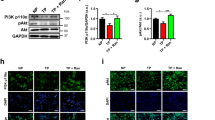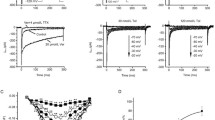Abstract
A repolarizing conduction in the heart augmented by hyposmotic or mechanically induced membrane stretch is the slow component of delayed rectifier K+ current (I Ks). I Ks upregulation is recognized as a factor promoting appearance of atrial fibrillation (AF) since gain-of-function mutations of the channel genes have been detected in congenital AF. Mechanical stretch activates angiotensin II type 1 (AT1) receptor in the absence of its physiological ligand angiotensin II. We investigated the functional role of AT1 receptor in I Ks enhancement in hyposmotically challenged guinea pig atrial myocytes using the whole-cell patch-clamp method. In atrial myocytes exposed to hyposmotic solution with osmolality decreased to 70% of the physiological level, I Ks was enhanced by 84.1%, the duration of action potential at 90% repolarization (APD90) was decreased by 16.8%, and resting membrane potential was depolarized (+4.9 mV). The hyposmotic-induced effects on I Ks and APD90 were significantly attenuated by specific AT1 receptor antagonist candesartan (1 and 5 μM). Pretreatment of atrial myocytes with protein tyrosine kinase inhibitors tyrphostin A23 and A25 suppressed but the presence of tyrosine phosphatase inhibitor orthovanadate augmented hyposmotic stimulation of I Ks. The above results implicate AT1 receptor and tyrosine kinases in the hyposmotic modulation of atrial I Ks and suggest acute antiarrhythmic properties of AT1 antagonists in the settings of stretch-related atrial tachyarrhythmias.







Similar content being viewed by others
References
Allessie M, Ausma J, Schotten U (2002) Electrical, contractile and structural remodeling during atrial fibrillation. Cardiovasc Res 54:230–246
Bers DM (2002) Cardiac excitation-contraction coupling. Nature 415:198–205
Boyd DF, Mathie A (2002) Inhibition of the potassium current IKSO, in cerebellar granule cells, by the inhibitors of MEK1 activation, PD 98059 and U 0126. Neuropharmacology 42:221–228
Browe DM, Baumgarten CM (2003) Stretch of β1 integrin activates an outwardly rectifying chloride current via FAK and Src in rabbit ventricular myocytes. J Gen Physiol 122:689–702
Caballero R, Delpón E, Valenzuela C et al (2001) Direct effects of candesartan and eprosartan on human cloned potassium channels involved in cardiac repolarization. Mol Pharmacol 59:825–836
Calkins H, el-Atassi R, Kalbfleisch S et al (1992) Effects of an acute increase in atrial pressure on atrial refractoriness in humans. Pacing Clin Electrophysiol 15:1674–1680
Chen YH, Xu SJ, Bendahhou S et al (2003) KCNQ1 gain-of-function mutation in familial atrial fibrillation. Science 299:251–254
Cohen DM (2005) SRC family kinases in cell volume regulation. Am J Physiol Cell Physiol 288:C483–493
Collard CD, Gelman S (2001) Pathophysiology, clinical manifestations, and prevention of ischemia-reperfusion injury. Anesthesiology 94:1133–1138
Davis MJ, Wu X, Nurkiewicz TR et al (2001) Regulation of ion channels by protein tyrosine phosphorylation. Am J Physiol Heart Circ Physiol 281:H1835–1862
Ding WG, Toyoda F, Matsuura H (2004) Regulation of cardiac I Ks potassium current by membrane phosphatidylinositol 4, 5-bisphosphate. J Biol Chem 279:50726–50734
Dostal DE (2000) The cardiac renin-angiotensin system: novel signaling mechanisms related to cardiac growth and function. Regul Pept 91:1–11
Du XL, Gao Z, Lau CP et al (2004) Differential effects of tyrosine kinase inhibitors on volume-sensitive chloride current in human atrial myocytes: evidence for dual regulation by Src and EGFR kinases. J Gen Physiol 123:427–439
Du XY, Sorota S (1997) Cardiac swelling-induced chloride current depolarizes canine atrial myocytes. Am J Physiol Heart Circ Physiol 41:H1904–H1916
Ehrlich JR, Hohnloser SH, Nattel S (2006) Role of angiotensin system and effects of its inhibition in atrial fibrillation: clinical and experimental evidence. Eur Heart J 27:512–518
Grunnet M, Jespersen T, MacAulay N et al (2003) KCNQ1 channels sense small changes in cell volume. J Physiol 549:419–427
Hagiwara N, Masuda H, Shoda M et al (1992) Stretch-activated anion currents of rabbit cardiac myocytes. J Physiol 456:285–302
Hamill OP, Marty A, Neher E et al (1981) Improved patch-clamp techniques for high-resolution current recording from cells and cell-free membrane patches. Pflügers Arch 391:85–100
Harada K, Komuro I, Hayashi D et al (1998) Angiotensin II type 1a receptor is involved in the occurrence of reperfusion arrhythmias. Circulation 97:315–317
Henry WL, Morganroth J, Pearlman AS et al (1976) Relation between echocardiographically determined left atrial size and atrial fibrillation. Circulation 53:273–279
Kocic I, Hirano Y, Hiraoka M (2001) Ionic basis for membrane potential changes induced by hypoosmotic stress in guinea-pig ventricular myocytes. Cardiovasc Res 51:59–70
Kubota T, Horie M, Takano M et al (2002) Role of KCNQ1 in the cell swelling-induced enhancement of the slowly activating delayed rectifier K+ current. Jpn J Physiol 52:31–39
Li GR, Feng J, Yue L et al (1996) Evidence for two components of delayed rectifier K+ current in human ventricular myocytes. Circ Res 78:689–696
Malhotra R, Sadoshima J, Brosius FC 3rd et al (1999) Mechanical stretch and angiotensin II differentially upregulate the renin-angiotensin system in cardiac myocytes in vitro. Circ Res 85:137–146
Marrero MB, Schieffer B, Paxton WG et al (1995) Direct stimulation of Jak/STAT pathway by the angiotensin II AT1 receptor. Nature 375:247–250
Missan S, Lindsdell P, McDonald TF (2008) Involvement of tyrosine kinase in the hyposmotic stimulation of I Ks in guinea-pig ventricular myocytes. Pflügers Arch 456(3):489–500
Missan S, Linsdell P, McDonald TF (2006) Role of kinases and G-proteins in the hyposmotic stimulation of cardiac IKs. Biochim Biophys Acta 1758:1641–1652
Nakashima H, Kumagai K, Urata H et al (2000) Angiotensin II antagonist prevents electrical remodeling in atrial fibrillation. Circulation 101:2612–2617
Nattel S (2002) New ideas about atrial fibrillation 50 years on. Nature 415:219–226
Nazir SA, Lab MJ (1996) Mechanoelectric feedback and atrial arrhythmias. Cardiovasc Res 32:52–61
Otway R, Vandenberg JI, Guo G et al (2007) Stretch-sensitive KCNQ1 mutation A link between genetic and environmental factors in the pathogenesis of atrial fibrillation? J Am Coll Cardiol 49:578–586
Pedersen SF, Beisner KH, Hougaard C et al (2002) Rho family GTP binding proteins are involved in the regulatory volume decrease process in NIH3T3 mouse fibroblasts. J Physiol 541:779–796
Ravelli F, Allessie M (1997) Effects of atrial dilatation on refractory period and vulnerability to atrial fibrillation in the isolated Langendorff-perfused rabbit heart. Circulation 96:1686–1695
Ravens U (2003) Mechano-electric feedback and arrhythmias. Prog Biophys Mol Biol 82:255–266
Ren Z, Raucci FJ, Browe DM et al (2008) Regulation of swelling-activated Cl- current by angiotensin II signaling and NADPH oxidase in rabbit ventricle. Cardiovasc Res 77:73–80
Richards EM, Lu D, Zelezna B et al (1993) Inhibition of central angiotensin responses by angiotensin type-1 receptor antibody. Hypertension 21:1062–1065
Robinson MJ, Cheng M, Khokhlatchev A et al (1996) Contributions of the mitogen-activated protein (MAP) kinase backbone and phosphorylation loop to MEK specificity. J Biol Chem 271:29734–29739
Roos K (1986) Length, width, and volume changes in osmotically stressed myocytes. Am J Physiol Heart Circ Physiol 251:H1373–H1378
Sadoshima J, Qiu Z, Morgan JP et al (1996) Tyrosine kinase activation is an immediate and essential step in hypotonic cell swelling-induced ERK activation and c-fos gene expression in cardiac myocytes. EMBO J 15:5535–5546
Sakaguchi M, Matsuura H, Ehara T (1997) Swelling-induced Cl- current in guinea-pig atrial myocytes: inhibition by glibenclamide. J Physiol 505(1):41–52
Sanfilippo AJ, Abascal VM, Sheehan M et al (1990) Atrial enlargement as a consequence of atrial fibrillation. A prospective echocardiographic study. Circulation 82:792–797
Sasaki N, Mitsuiye T, Wang Z et al (1994) Increase of the delayed rectifier K+ and Na+-K+ pump currents by hypotonic solutions in guinea pig cardiac myocytes. Circ Res 75:887–895
Schmieder RE, Hilgers KF, Schlaich MP et al (2007) Renin-angiotensin system and cardiovascular risk. Lancet 369:1208–1219
Torsoni AS, Marin TM, Velloso LA et al (2005) RhoA/ROCK signaling is critical to FAK activation by cyclic stretch in cardiac myocytes. Am J Physiol Heart Circ Physiol 289:H1488–H1496
Touyz RM, Schiffrin EL (2000) Signal transduction mechanisms mediating the physiological and pathophysiological actions of angiotensin II in vascular smooth muscle cells. Pharmacol Rev 52:639–672
Vandenberg JI, Bett GCL, Powell T (1997) Contribution of a swelling-activated chloride current to changes in the cardiac action potential. Am J Physiol Cell Physiol 42:C541–C547
Vandenberg JI, Rees SA, Wright AR et al (1996) Cell swelling and ion transport pathways in cardiac myocytes. Cardiovasc Res 32:85–97
Wang Z, Fermini B, Nattel S (1994) Rapid and slow components of delayed rectifier current in human atrial myocytes. Cardiovasc Res 28(10):1540–1546
Wang Z, Mitsuiye T, Noma A (1996) Cell distension-induced increase of the delayed rectifier K+ current in guinea pig ventricular myocytes. Circ Res 78:466–474
Wold LE, Relling DP, Duan J et al (2002) Abrogated leptin-induced cardiac contractile response in ventricular myocytes under spontaneous hypertension: role of Jak/STAT pathway. Hypertension 39:69–74
Yasuda N, Miura S-I, Akazawa H et al (2008) Conformational switch of angiotensin II type 1 receptor underlying mechanical stress-induced activation. EMBO Rep 9(2):179–186
Zankov DP, Omatsu-Kanbe M, Isono T et al (2006) Angiotensin II potentiates the slow component of delayed rectifier K+ current via the AT1 receptor in guinea pig atrial myocytes. Circulation 113:1278–1286
Zhou YY, Yao JA, Tseng GN (1997) Role of tyrosine kinase activity in cardiac slow delayed rectifier channel modulation by cell swelling. Pflügers Arch 433:750–757
Zou Y, Akazawa H, Qin Y et al (2004) Mechanical stress activates angiotensin II type 1 receptor without the involvement of angiotensin II. Nat Cell Biol 6:499–506
Acknowledgments
This study was supported by Japanese Society for the Promotion of Science, research grant no 19-07209.
Disclosures
The authors have no potential conflict of interests.
Author information
Authors and Affiliations
Corresponding author
Rights and permissions
About this article
Cite this article
Zankov, D.P., Toyoda, F., Omatsu-Kanbe, M. et al. Angiotensin II type 1 receptor mediates partially hyposmotic-induced increase of I Ks current in guinea pig atrium. Pflugers Arch - Eur J Physiol 458, 837–849 (2009). https://doi.org/10.1007/s00424-009-0669-8
Received:
Accepted:
Published:
Issue Date:
DOI: https://doi.org/10.1007/s00424-009-0669-8




